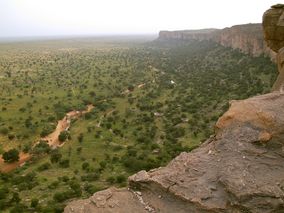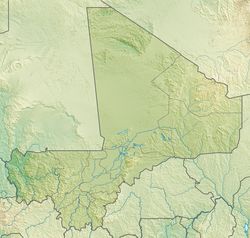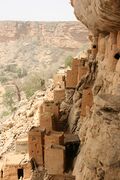جرف باندياغارا
| جرف باندياگارا Bandiagara Escarpment | |
|---|---|
IUCN category III (natural monument or feature) | |
 جرف باندياگارا من بانيموتو | |
| الموقع | منطقة موپتي، مالي |
| تأسست | 1985 |
| موقع تراث عالمي لليونسكو | |
| Official name | Falaise de Bandiagara |
| جزء من | Cliff of Bandiagara (Land of the Dogons) |
| السمات | ثقافي وطبيعي: (v), (vii) |
| مراجع | 516 |
| التدوين | 1989 (13 Session) |
| المساحة | 326,950 ha (1,262.4 sq mi) |
| الإحداثيات | 14°20′N 3°25′W / 14.333°N 3.417°W |
قالب:Traditional African religion
| صخور باندياغارا | |
|---|---|
 قرية التيليم بنيت على جانب جرف باندياغارا المأهولة من قبل شعب الدوغون | |
| الدولة | |
| النوع | مختلط |
| المعايير | v ,vii |
| رقم التعريف | 516 |
| المنطقة | أفريقيا ** |
| تاريخ الاعتماد | |
| السنة | 1989 (الاجتماع الثالث عشر للجنة التراث العالمي) |
| ملحق | http://whc.unesco.org/ar/list/516# |
| * اسم الموقع كما هو مدون بقائمة مواقع التراث العالمي ** تقسييم اليونسكو لمناطق العالم | |
| تعديل |
|
يملك جرف باندياگارا، بالإضافة إلى مناظره الطبيعية الخلابة المؤلّفة من الصخور والهضبات الرمليّة التي تتميّز بالهندسات الجميلة (كالبيوت ومخازن الغلال والمعابد والملاجئ)، تقاليدَ اجتماعيّةً مدهشةً لا تزال تُمارَس حتى اليوم (كالأقنعة والاحتفالات الدينيّة والشعبيّة والشعائر الدينيّة التي تُقام بصورةٍ دوريّةٍ للأجداد في مناسباتٍ عديدة). وتُعتبر هضبة باندياغارا أحد أهم المواقع في غرب أفريقيا ويعود ذلك إلى صفاتها الجيولوجيّة والأثريّة وتنوّع الشعوب التي سكنتها ومناظرها الطبيعيّة.
«جرف باندياجارا» احدى عجائب الطبيعة فهو عبارة عن واجهة صخرية ترتفع الى حوالي 300 متر من الصحراء وفيها اقامت قبيلة «تـِلـِّم» تجمعاتها السكانية التي ترجع الى عام 300 ق.م. والسبيل الوحيد الذي يمكن بواسطته الوصول الى بيوتهم الصخرية التي ساعد طقس الصحراء الجاف على المحافظة على محتوياتها تماما فهو استخدام حبال تتدلى من قمة ذلك الجرف.
. . . . . . . . . . . . . . . . . . . . . . . . . . . . . . . . . . . . . . . . . . . . . . . . . . . . . . . . . . . . . . . . . . . . . . . . . . . . . . . . . . . . . . . . . . . . . . . . . . . . . . . . . . . . . . . . . . . . . . . . . . . . . . . . . . . . . . . . . . . . . . . . . . . . . . . . . . . . . . . . . . . . . . . .
التاريخ
The cave-dwelling Tellem, an ethnic group later pushed out by the arrival of the Dogons, used to live in the slopes of the cliff. The Tellem legacy is evident in the caves they carved into the cliffs so that they could bury their dead high up, far from the frequent flash floods of the area.
Dozens of villages are located along the cliff, such as Kani Bonzon. It was near this village that the Dogons arrived in the 14th century, and from there they spread over the plateau, the escarpment and the plains of the Seno-Gondo.
According to local oral history, the Dogon were relatively undisturbed by French colonial powers due to natural tunnels weaving through the Bandiagara Escarpment. Only the Dogon knew of the tunnels, and were able to use them to ambush and repel aggressors.
The Bandiagara Escarpment today
Today, local guides escort tourist groups along the escarpment to visit Dogon villages. A series of trails runs along the cliffs, and hostels in each village provide food and lodging. The host villages receive income from the hostels and the tourist tax. Large increases in tourism to the area are expected, as a new highway is constructed, putting pressure on local, traditional cultures.[1] In addition, The Independent reports that looting of ancient artifacts is widespread in the area, which is poorly policed.[2]
To call attention to the issue of uncontrolled tourist visitation, the World Monuments Fund included the Bandiagara Escarpment in the 2004 World Monuments Watch. In 2005, WMF provided a grant from American Express to the Mission Culturelle de Bandiagara for the development of a management plan.[3] Beyond the protection of traditional buildings, the management plan calls for the regulation of new construction through the establishment of strict building guidelines, such as those that govern new development in historic districts around the world.
After the 2012 war in Mali, central areas of the country, including the Dogon Plateau and Bandiagara Escarpment, have become increasingly dangerous. Terrorist groups operate in the area, and violence between local ethnicities occurs on a daily basis.
As of 2018, it is extremely inadvisable to travel to this area for tourism, and Malian security forces have been known to turn back those who attempt to do so. In March 2018, an armed group attacked a hotel frequented by UN staff in the town of Bandiagara, killing several people.[4]
معرض
Remnant dwellings of the ancient Tellem people in the background, above the abandoned Dogon village; a mud mosque of the modern-day Dogon village is visible in the foreground
- Bandiagara escarpment 2.jpg
See also
الهامش
- ^ Baxter, Joan (16 April 2001). "Mali: What Price Tourism?". BBC News.
- ^ Smith, Alex Duval (17 March 2001). "Mali Plunders its Desert Heritage to Feed Demand for 'Primitive' Art". The Independent.[dead link]
- ^ World Monuments Fund - Bandiagara Escarpment Cultural Landscape
- ^ "Gunmen storm hotel in brutal attack – two dead". 29 March 2018.
وصلات خارجية
- UNESCO - Cliff of Bandiagara (Land of the Dogons)
- Thierry Joffroy and Lassana Cissé, "Culture at a Crossroads: For Mali’s Bandiagara Escarpment, extraordinary geology and human genius have conspired to create one of the world’s great cultural landscapes. For the Dogon cliff-dwellers who live there, the future hangs in the balance." ICON Magazine, Fall 2005, p. 38-45.




